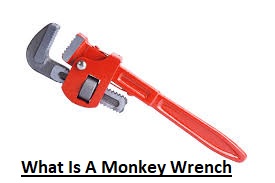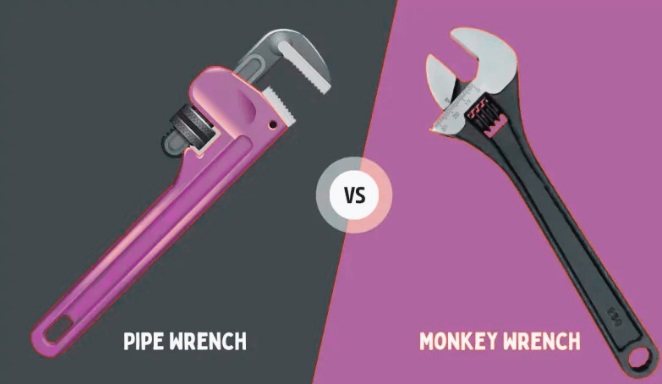There are different types of wrenches, and each is used for certain operations. The basic types of wrenches are pipe wrenches and monkey wrenches. The basic difference between a monkey wrench and a pipe wrench is based on location; they are used for different applications.
A pipe wrench is also called a monkey wrench, and here we will cover details for both of them and their practical uses. So let’s get started.
What Is A Monkey Wrench?
- The monkey wrench is the first type of adjustable wrench and is used for different industrial uses.
- This tool also became important for the 2nd Industrial Revolution since it needed low space and used less time for working.
- But it’s the first time it’s still not used, and who invented this tool? But it is an idea that was first used in the mid-1800s.
- It is said that it was first used in the USA by mechanic Charles Moncky. The main idea is that many people made this wrench in different countries, but it was commonly used by the brand BAHCO in the 1900s.
- A monkey wrench means an adjustable wrench, and it is also called an adjustable spanner, which is a wrench that comes with jaws that open and close along the x-axis.
- Its jaws are in alignment with the handle and open outward through the tip of the tool.
- This type of wrench comes with smooth, flat jaws that are parallel to each other.
- Monkey wrenches are good tools to use for vehicle mechanics, maintenance of machines, and handymen. their design is such that it makes it easy to tighten and loosen hexagonal nuts and bolts without any damage, since it comes with smooth jaws.
What Is A Pipe Wrench?
- The pipe wrench is a wrench type that is used for securing, fitting, and loosening components for pipe systems.
- It comes with adjustable jaws that expand for gripping different pipe sizes.
- Pipe wrenches are used for connecting, removing, and repairing pipes and pipe fittings.
- It is also used to loosen or tighten circular fittings, for example, tees, couplings, and elbows.
- Pipe wrenches are also employed for installing valves, connectors, and other parts of pipes.
- It has a long handle that helps to apply high torque for tightening and loosening pipes.
Monkey Wrench vs. Pipe Wrench
The basic differences between monkey wrenches and pipe wrenches are as
Adjustable Jaws
- The basic difference is the design of adjustable jaws. The monkey wrench comes with two smooth jaws. Its lower jaw moves up and down the shaft for gripping objects with different dimensions.
- Pipe wrench comes with serrated teeth on fixed and pivoting jaws. The pivoting jaws move to expand and properly grip pipes.
Working Range
- Since they come with different jaw designs, they can be used for different uses and ranges. The monkey wrench is good for providing a strong grip and turning nuts. But it is not good to use for pipe gripping.
- A pipe wrench is made for gripping and rotating cylindrical objects such as pipes and pipe fittings and does not work for nuts and bolts.
Mechanical Features
- The pipe wrench comes with a longer handle lever for providing higher torque. So it is good for loosening and tightening pipe fittings that needed high force due to a stuck design. Monkey wrenches come with short handles that give low mechanical features. It is good for basic DIY operations but less effective for strong fasteners.
Strong Grip
- The grip strength and accuracy also affect their working. The pipe wrench comes with angled teeth and pivoting jaws that provide a strong grip for pipes.
- Monkey wrench sliding jaws do not provide strong fitting through fasteners. It can damage nut and bolt heads.
Chances for Damage
- Both come with different jaws, so each provides a different damaging effect. Monkey wrenches come with smooth jaws that do less damage to smooth surfaces.
- Angled and pointed teeth of a pipe wrench can affect smooth pipes and surfaces if not accurately used.
Dimension
- Monkey wrenches range from 6 to 24 inches in length and come in a compact design. Pipe wrenches are larger in size, with dimensions of 10 to 48 inches for handling larger pipe diameters.
- Their larger size helps to produce high torque.
Ease of Use
- Monkey wrenches are easy to use and practical for working; just put the jaws over the nut and turn.
- For pipe wrenches, set curved jaws with an accurate size for fitting pipe and tightening to increase grip force for turning. So their work is more complex than monkey wrenches.
How To Use A Monkey Wrench?
- For the practical use of a monkey faster than needed to put on or remove. After that, apply the screw process of the wrench to tighten over the fastener.
- If needed to drive in fasteners, turn the monkey wrench in a clockwise direction.
- For loosening purposes, rotate the monkey wrench in an anticlockwise direction. After completing work with the screwing process, remove the wrench.
- Monkey wrench also used as an emergency, makeshift hammer
How To Use A Pipe Wrench?
- There is not certain difference between pipe wrench and monkey wrench working.
- The basic difference is that for adjusting the lower jaws of a monkey wrench, there is a need to set the upper jaw of the pipe wrench.
- Put the jaw of the wrench over the pipe for setting and use the screw process for the connection of the jaw.
- After that, move it in a clockwise direction to tighten and counterclockwise to loosen.
- After that, use the screw process to make a weak grip on the pipe.
- Pipe wrenches are also used for removing or breaking rusty metal joints and loosening rusty or worn-out bolts and also help assemble or disassemble regular hex
Monkey Wrench vs. Pipe Wrench: Which One Is Best?
Monkey wrenches and pipe wrenches are different for different uses. Monkey wrenches are good to use for loosening and fastening nut and bolt heads. It is due to parallel fixed jaws that help to make a strong grip. They also have a simple design and easy-to-use features for using flats and hexes options.
Pipe wrenches are made for gripping and turning round pipes and fittings for various purposes. It is larger in size and curved in shape with adjustable jaws and comes with high torque features for pipe requirements.
The monkey wrench provides strong fitting and control for nuts, bolts, and different flat surface hardware.
For installing, removing, and repairing pipes, the best is to use a pipe wrench.
What should be considered for buying a wrench?
There are different factors that we must consider before buying a pipe wrench and monkey wrench. That are explained here
Durable Structure
- For the selection of any tools, check its durability. use a wrench that is designed with heavy-duty materials like steel or aluminum.
- This materials helps to increase working life of wrenches, either use for a long time
Weight and dimensions
- There are different shapes and dimensions for pipes and fasteners. So check that the wrench selected accurately fits the fasteners and pipes you’re working on. Pipe wrenches have different sizes, so use a pipe that can be accurately fitted.
- Based on size and weight, heavy-duty wrenches come with high weight since they use high-density materials.
- Use lightweight tools since they are easy to use many times.
tool grip
- Use such tools that provide easy gripping for longer uses. Rubber is used for gripping purposes. that provides an easy grip for the hand even if you are using it for a longer time. Not all types of wrenches have comfortable grips, so use one that has an easy grip.
Jaw Design
- For monkey and pipe wrench use, design the jaw according to the fitting surface for proper working. if you are working on rounded surfaces like pipe use jaws with teeth.
- Teeth provide a strong grip on pipe for loosening and tightening.
Conclusion
Pipe wrenches and monkey wrenches are good tools for different wrench work, and each has a different purpose. Monkey wrenches are used for nuts and bolts head fastening and loosening and pipe wrenches are used for gripping and tunrnig pipes.
Each has its own uses and limitations, so use accurate tools for the required work. Their difference helps to find them for certain operations that provide an effective job during use.

